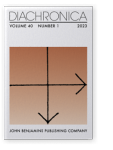Vol. 40:1 (2023) ► pp.1–29
Agreement in Kadu
Inflectional merger as morphosyntactic abstraction
Krongo, a member of the Kadu family (Nuba Mountains, Sudan), has four agreement classes: feminine, masculine, neuter and plural (Reh 1985). Nominal number-marking prefixes play a key role in class assignment: productive plural prefixes trigger plural agreement, and productive singular prefixes trigger neuter agreement. In most other Kadu languages, there is no distinction between plural and neuter classes. Comparative and typological evidence shows that Krongo’s system represents the older state of affairs. It is argued that the motivation for the merger of these two classes was a morphosyntactic abstraction over agreement rules. Two distinct rules, one for singular prefixes and one for plural prefixes, were replaced by a single rule that assigned the same agreement class to all productive number prefixes, regardless of whether they mark singular or plural. The result is the morphosyntactic mirror-image of an inverse number system, such as is found in, for example, Dagaare (Grimm 2012).
Article outline
- 1.Introduction
- 2.Gender, agreement and noun morphology in the Kadu languages
- 3.Evidence for the merger of agreement classes
- 3.1Agreement on nominal modifiers
- 3.2Morphological and lexical correspondences
- 3.3First singular/second singular n-
- 3.4A note on third person pronouns
- 3.5Interim summary
- 4.Class merger as morphosyntactic abstraction
- 5.Conclusion
- Acknowledgements
- Notes
- Abbreviations
-
References
